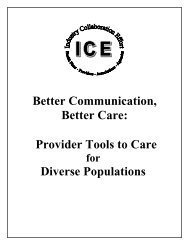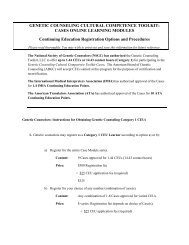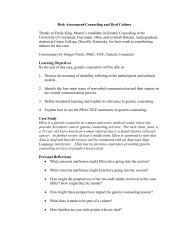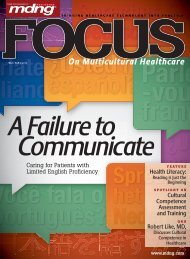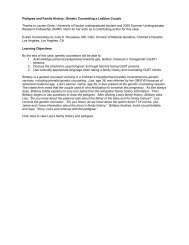Advanced Effective Communication, Cultural Competence, and ...
Advanced Effective Communication, Cultural Competence, and ...
Advanced Effective Communication, Cultural Competence, and ...
You also want an ePaper? Increase the reach of your titles
YUMPU automatically turns print PDFs into web optimized ePapers that Google loves.
Chapter One<br />
ADMISSION<br />
The admission process is typically the initial point of contact<br />
a patient has with the hospital. Key patient information is<br />
collected during admission <strong>and</strong> used for identification,<br />
billing, <strong>and</strong> care planning purposes. In addition, patients<br />
receive a significant amount of information from the hospital,<br />
including patient rights documents <strong>and</strong> relevant hospital<br />
policies. As patients <strong>and</strong> their families interact with staff at<br />
the registration desk <strong>and</strong> complete admission forms <strong>and</strong><br />
paperwork, the admission phase of the care continuum<br />
provides hospitals with the first opportunity to identify <strong>and</strong><br />
address the unique needs of their patients.<br />
✔ Checklist to Improve<br />
<strong>Effective</strong> <strong>Communication</strong>,<br />
<strong>Cultural</strong> <strong>Competence</strong>, <strong>and</strong><br />
Patient- <strong>and</strong> Family-Centered<br />
Care During Admission<br />
❑<br />
❑<br />
❑<br />
❑<br />
❑<br />
❑<br />
❑<br />
❑<br />
Inform patients of their rights.<br />
Identify the patient’s preferred language<br />
for discussing health care.<br />
Identify whether the patient has a sensory<br />
or communication need.<br />
Determine whether the patient needs<br />
assistance completing admission forms.<br />
Collect patient race <strong>and</strong> ethnicity data in<br />
the medical record.<br />
Identify if the patient uses any assistive devices.<br />
Ask the patient if there are any additional<br />
needs that may affect his or her care.<br />
Communicate information about unique<br />
patient needs to the care team.<br />
This chapter focuses on the identification of several basic patient<br />
needs that must be addressed throughout the care continuum.<br />
Information regarding communication preferences <strong>and</strong> needs,<br />
cultural, religious or spiritual background, preferences <strong>and</strong><br />
needs, mobility requirements, <strong>and</strong> other patient needs is<br />
essential for staff to help in the admission process to plan for<br />
appropriate services or accommodations. Any data collected<br />
during admission should be easily accessible at all points of care<br />
<strong>and</strong> in other relevant departments in the hospital.<br />
Although the majority of patients will enter the hospital<br />
through the scheduled admission process, some patients will<br />
experience emergency admissions. For these patients, hospitals<br />
should adapt the recommendations included in this chapter<br />
to make sure that necessary patient-level data are collected<br />
by the clinical staff <strong>and</strong> that the hospital disseminates<br />
information to patients <strong>and</strong> families through alternative<br />
channels.<br />
The next section includes both recommended issues to<br />
address during admission (with check boxes) <strong>and</strong> practice<br />
examples (with round bullets). While the recommended issues<br />
present broad, overarching concepts that all hospitals should<br />
address, the example practices <strong>and</strong> methods may not apply to<br />
all hospital types, sizes, or settings.<br />
Recommended Issues <strong>and</strong><br />
Related Practice Examples to<br />
Address During Admission<br />
❑ Inform patients of their rights.<br />
Several patient rights address the unique needs of<br />
individuals, such as the right to have a language<br />
interpreter, the right to receive accomodation for a<br />
disability, the right to be free from discrimination when<br />
receiving care, the right to identify a support person to<br />
be present during the hospital stay, <strong>and</strong> the right to<br />
designate a surrogate decision-maker. There are several<br />
ways to make sure that patients are informed of their<br />
rights in a manner that supports their involvement in<br />
their care, including the following:<br />
• Post relevant hospital policies (in the most<br />
frequently encountered languages) in the waiting<br />
room.<br />
• Include information about relevant hospital policies<br />
in patient Bill of Rights documents.<br />
• Provide patient rights materials in multiple languages<br />
<strong>and</strong> alternative formats (for example, audio, visual, or<br />
written materials).<br />
• Explain the right to have a language interpreter, the<br />
role of the interpreter in the health care encounter, <strong>and</strong><br />
9



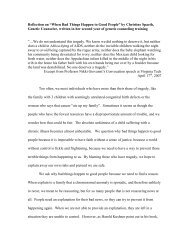
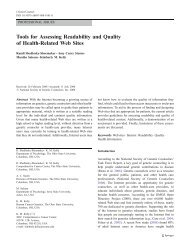

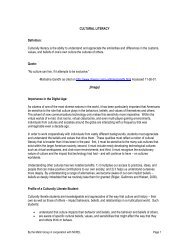
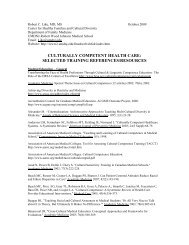

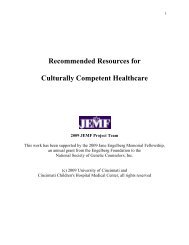

![Breaking Bad News PPT[1] - Genetic Counseling Cultural ...](https://img.yumpu.com/35003134/1/190x146/breaking-bad-news-ppt1-genetic-counseling-cultural-.jpg?quality=85)
